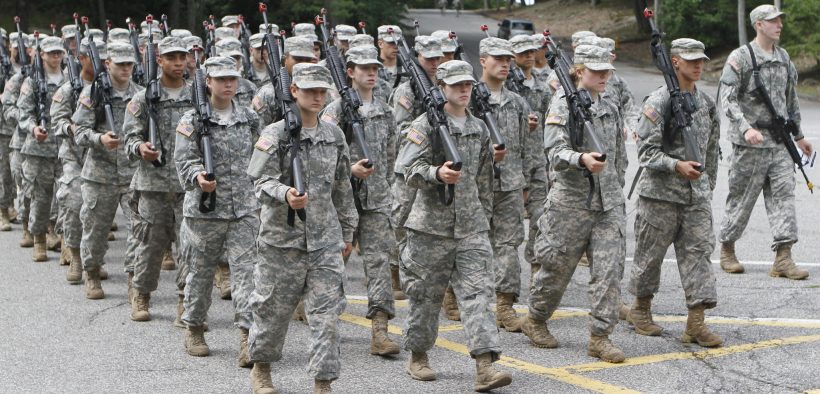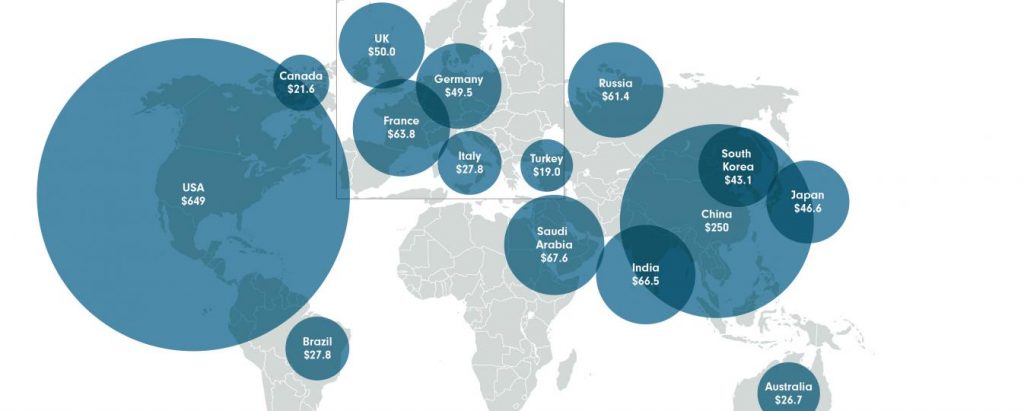US and China Drive Global Military Spending to Highest Level Since Cold War

“Too many people have too much money invested in war.”
According to a new study, Global military spending in 2018 reached its highest level since the end of the Cold War era, triggered by an increase in defense spending from the U.S. and China.
The Stockholm International Peace Research Institute (SIPRI) annual report released on Monday revealed that global military expenditure in 2018 rose to $1.82 trillion, up 2.6 percent from the previous year. This figure is the highest global military spending has been since 1988 – the first year for which consistent global data is available and, notably, just after the Cold War ended.
U.S. military spending accounted for 36 percent of the global totals, reaching $649 billion for the first time in seven years, up 4.6 percent from the U.S.’ 2017 budget. The top five big spenders in the SIPRI list (the U.S., China, Saudi, India and France) accounted for 60 percent of overall defense expenditures.

Top military spenders (Graphic: SIPRI)
U.S. President Donald Trump has committed to strengthening national defense amid a plan to reduce the number of troops in conflict-prone countries such as Afghanistan and Syria – despite controversy surrounding his plans.
“The increase in US spending was driven by the implementation from 2017 of new arms procurement programmes under the Trump administration,” said SIPRI AMEX Program Director Aude Fleurant in the report.
In 2018, Congress provided an additional budget of $61 billion to the U.S. military, the “most massive military budget in history,” according to Defense Secretary Jim Mattis.
This year, Trump has proposed an increase in defense spending of up to $33 billion, a 5 percent increase compared to the 2018 budget. The increase in defense means budget cuts in other areas such as diplomacy and development, worth $13 billion. There have also been reports that Trump is going to propose a $750 billion defense budget for 2020.
Despite the Weakening Economy, China Consistently Increases its Military Spending
China came second behind the U.S. in the SIPRI’s index by allocating $250 billion to defense in 2018, a 5 percent increase over compared to the previous year.
“Whether a country would pose a military threat to other countries depends on the country’s foreign and defense policies, rather than how much it will increase its defense spending,” Zhang Yesui, spokesman of the National People’s Congress said to the South China Morning Post.
“In 2018, China spent about 1.3 percent of its gross domestic product on defense, while the proportion of GDP of many other key developed countries’ defense expenditure was more than 2 percent.
China has allocated around 1.9 percent of its GDP to boost its military since 2013. So far, Beijing has modernized its military by developing stealth war jets and anti-satellite missiles. In addition, China is planning to boost its defense budget by 7.5 percent ($177.49 billion), somewhat lower than the initial target of 8.1 percent.
China’s Prime Minister Li Keqiang said the revision in the military spending target was due to the lower economic growth target of 6.5 percent. Five years ago, China’s defense budget was in the double digits. The budget will be used to modernize its military, by funding missiles and secret troops.
China’s defense budget skyrocketed at double-digit rates from 1989 to 2015 as the mainland began to revamp its military. Yet, that growth fell to single digits in 2016 after President Xi Jinping planned to slash 300,000 personnel, although total defense expense has since hit almost 1 trillion yuan (US $149 billion).
Russia Is No Longer a Big Spender
For the first time, Russia was excluded from the top five countries with the largest military expenses. In 2018, Russia’s military spending slipped 3.5 percent compared to 2017 expenditures, placing Russia in sixth place just after France. France spent $63.8 billion on defense compared to Russia’s $61.4.
SIPRI noted that Russia’s decrease in the defense budget happened after Moscow’s expansion in Ukraine. Russia seized Crimea from Ukraine in 2014 and supported separatists in the eastern part of the country. Moscow also has some unresolved disputes with Baltic states such as Latvia and Lithuania, following some air and sea provocations, direct attacks and military exercises in the Baltic Sea.
On the other hand, as Russian expenditures fell, military expenses in some Central and Eastern European countries rose. Poland’s defense budget rose 8.9 percent in 2018, and Ukraine’s defense budget jumped 21 percent to $4.8 billion.
The increase in the defense budget in Central Europe is linked with a growing perception of Russia as a threat, as SIPRI wrote in the report. In 2018, countries in the region spent $28.3 billion on war equipment, a 35 percent increase from 2009, reflecting a 12 percent annual increase.
What Triggered the Increase in Global Military Spending?

Protest against war funding at the office of Representative McCollum. St. Paul, Minnesota. May 18, 2010 (Photo: Fibonacci Blue)
The rivalry between the U.S. and China, the India-Pakistan conflict and Central Europe’s fear of a Russian threat have contributed to a global increase in military spending. India, for example, ranked fourth out of the top five countries with the largest defense spending, as it upped its budget for arms in 2018.
Pieter Wezeman, a senior researcher at the SIPRI Arms and Military Expenditure (AMEX) program, told RT: “The tensions between countries in Asia as well as between China and the USA are major drivers for the continuing growth of military spending in the region.”
Concern over North Korea’s uncertain denuclearization promises also pushed Japan to boost its military budget. Tokyo is planning to buy arms from the U.S. and expand its defense budget for the next five years, as Nikkei Asian Review reported in December.
The country’s Defense Minister will likely allocate $240 billion between April 2019 and March 2024, with a spending average increasing around 1.1 percent annually, the report said without specifying the source.
The SIPRI report showed that there are no signs that tensions worldwide will be reduced and the tendency of growing military spending will only benefit arms producers.
“Too many people have too much money invested in war,” said Ted Seay, a former U.S. diplomat and senior policy consultant with the British American Security Information Council (BASIC).















